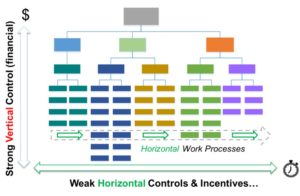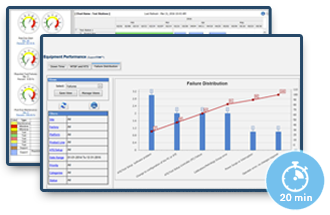

Plans are only as good as your ability to execute them. Equipment plans or budgets are more than lists of equipment, they help fulfill intentions in a larger plan to bring products to market faster and increase margins, profitability, and growth. When plans are not designed and executed with these intentions in mind they can’t possibly fulfill them, except by accident.
Our asset management plans always have these intentions in mind and when executed produce breakthrough results.
-
400% increases to utilization
-
25% to 75% capital budget savings
-
up to 50% increases to responsiveness, speed, and throughput in critical enterprise processes
Bottom’s Up Planning is Often Flawed
Planning is often thwarted because of something called “local optima”. It is a distinction from the Theory of Constraints discourse. It means that performance is optimized locally, for instance in a department. This local optimization thwarts the larger goals of the enterprise. Local optimization might make the department look good, but as the author of “The Goal” points out, they are only “vanity” metrics. Local optimization almost always causes constraints that affect the output, speed, and profitability of the whole business.
Budgeting in Functions
The conflict is shown in the organizational chart below. Planning and managing resource and equipment budgets are practices that are well established in large enterprises. These functional structures were established in the previous industrial revolution when efficiency was a competitive differentiator and where speed wasn’t anywhere near as important. As companies look to transform for speed they are learning these old structures are too rigid and must be modified. The tight “vertical” controls often are at cross-purposes and thwart the steady stream of work that happens horizontally, across the various functional departments. Costs saved upstream that makes one manager look good, could create a problem for another manager downstream more than offsetting any cost saved.

Planning and Managing the “Vertical” and the “Horizontal”
The plans we make to produce new competitive outcomes – to go faster or cost less – are always limited by the knowledge, tools, habits, and traditions found in our culture. If we are going to change our outcomes, our knowledge and practices need to change. The new practices need to be able to see the whole and anticipate how changes locally will affect the overall speed and output of the whole system. It must be able to plan and execute with “vertical” functional capabilities that optimize the total throughput and speed “horizontally.” To do this requires knowledge at all times of what resource, asset, and process constraints to anticipate across the horizontal and what contingencies are available across and “vertical” department.
Planning is a Team Sport
With Scireo, as cross-functional project teams plan their work, the effect on capacity in the functions is better understood and can be planned for. Anticipating capacity gaps and the likelihood of contingencies is essential. The knowledge of expected demand in each function, as well as planned and historical utilization, enables a well-informed inventory plan that includes:
-
Planned reuse of capabilities
-
Planned disposition of capabilities
-
Planned acquisition of capabilities – owned or rented depending on demand profiles and other competing capital projects
Execution is REALLY a Team Sport!
When executing a plan all functional team members have to coordinate their actions fluidly to keep a continuous flow of high-value projects running through the organization. Project teams that include project engineers, instrumentation engineers, data engineers, build technicians and test engineers with their teams all must coordinate impeccably focused on the strategic and ultimate intentions of the team for speed and competitiveness. That team must also coordinate impeccably with purchasing groups placing orders and suppliers shipping their product in time so that all is received on time avoiding any interruptions in flow. Every member of the team and suppliers have metrics aligning their activities to the goals of the team.
Dynamic Adjustment of Plans and Budget Line Items
With today’s pace of change, plans have to be constantly updated and monitored with a commitment to keeping throughput up and operating budgets on target. When you compare your plan to what actually happened it is likely to be pretty different. As Mike Tyson once said, “Everyone has a plan until they get punched in the mouth.” What matters is that the strategic intentions of speed and total cost are achieved. Some functions might be up, others down, but the larger team must achieve its goals. What matters is the team wins and everyone contributes.
Key Scireo Capabilities Make Cross-Functional Constraints Visible
Cross Function Integration enables cross-functional teams to see emerging resource constraints, whether they be people or equipment ranging from fixed capabilities, e.g. wind tunnels, EMI chambers, engine test cells, or test benches, to portable and sharable capabilities e.g. meters, scopes, or analyzers.
Embedded Contextual Knowledge of things like equipment capabilities or availability that reduce knowledge and resource constraints by enabling a quick assessment of contingencies in a fast-changing environment or enables more robust capital planning with knowledge of equipment obsolescence and health states.
Accountability Algorithms identify locations where policy or knowledge constraints produce perverse incentives (like hoarding) which leads to resource or knowledge constraints. Sente’s Accountability Practices and various tactical and strategic services are used to enable our Acceleration Algorithm.
Request a Demo

See how Scireo aEAM Software drops asset and support costs by 50% while accelerating time-to-market 2X.
Relevant Content
Reduce Time-to-Market by Anticipating Constraints
The Theory of Constraints (TOC) was widely popularized in Eli Goldratt’s best-selling book, “The Goal.” In our work in test, we’ve leveraged these principles to produce award-winning Enterprise Asset Management capabilities and results. Our customer talks about the results they got from anticipating constraints and having strategies to overcome them in Digital Transformation: Asset Management…
Drive Test Equipment Utilization to Enable Investments
Driving test equipment utilization is critical to meeting today’s competitive challenges. Freeing up capacity for innovation and growth has never been more important. Companies are being asked to bring products to market in half the time and reduce their cost of operations up to 50% to succeed against aggressive global competitors. In hi-tech manufacturing businesses,…
Case Study: Aerospace Company Drives One Company Synergies
Like many aerospace companies, this one had many sites and different legacy cultures on each. See how they installed common resource management tools, increased utilization 3X and funded new programs.
Equipment Utilization Case Study: Space Company Leverages Assets
The hoarding culture was slowing this company down while impacting cost and quality. See how a journey to common processes and collaboration lead to a 50% reduction in assets as their business doubled.
Notable Quotes
“The system Sente employs is very disciplined. What’s great about it is that it was developed with input from all of us. When I get a request that has come through their system, I have the sense that it’s complete and the equipment is really needed. It’s great to see the progress we’ve made in the last year.”
Manager, Purchasing








